Who
Scott Bender, operations and business advisor to Blue Knob ownership
Donna Himes, Blue Knob Marketing Manager
Sam Wiley, part owner of Blue Knob
Gary Dietke, Blue Knob Mountain Manager
Recorded on
May 13, 2024
About Blue Knob
Click here for a mountain stats overview
Owned by: Majority owned by the Wiley family
Located in: Claysburg, Pennsylvania
Year founded: 1963
Pass affiliations: Indy Pass and Indy+ Pass – 2 days, no blackouts (access not yet set for 2024-25 ski season)
Closest neighboring ski areas: Laurel (1:02), Tussey (1:13), Hidden Valley (1:14), Seven Springs (1:23)
Base elevation: 2,100 feet
Summit elevation: 3,172 feet
Vertical drop: 1,072 feet
Skiable Acres: 100
Average annual snowfall: 120 inches
Trail count: 33 (5 beginner, 10 intermediate, 4 advanced intermediate, 5 advanced, 9 expert) + 1 terrain park
Lift count: 5 (2 triples, 2 doubles, 1 carpet – view Lift Blog’s inventory of Blue Knob’s lift fleet)

Why I interviewed them
I’ve not always written favorably about Blue Knob. In a state where shock-and-awe snowmaking is a baseline operational requirement, the mountain’s system is underwhelming and bogged down by antiquated equipment. The lower-mountain terrain – Blue Knob’s best – opens sporadically, sometimes remaining mysteriously shuttered after heavy local snows. The website at one time seemed determined to set the world record for the most exclamation points in a single place. They may have succeeded (this has since been cleaned up):

I’ve always tried to couch these critiques in a but-damn-if-only context, because Blue Knob, considered purely as a ski area, is an absolute killer. It needs what any Pennsylvania ski area needs – modern, efficient, variable-weather-capable, overwhelming snowmaking and killer grooming. No one, in this temperamental state of freeze-thaws and frequent winter rains, can hope to survive long term without those things. So what’s the holdup?
My goal with The Storm is to be incisive but fair. Everyone deserves a chance to respond to critiques, and offering them that opportunity is a tenant of good journalism. But because this is a high-volume, high-frequency operation, and because my beat covers hundreds of ski areas, I’m not always able to gather reactions to every post in the moment. I counterbalance that reality with this: every ski area’s story is a long-term, ongoing one. What they mess up today, they may get right tomorrow. And reality, while inarguable, does not always capture intentions. Eventually, I need to gather and share their perspective.
And so it was Blue Knob’s turn to talk. And I challenge you to find a more good-natured and nicer group of folks anywhere. I went off format with this one, hosting four people instead of the usual one (I’ve done multiples a few times before, with Plattekill, West Mountain, Bousquet, Boyne Mountain, and Big Sky). The group chat was Blue Knob’s idea, and frankly I loved it. It’s not easy to run a ski area in 2024 in the State of Pennsylvania, and it’s especially not easy to run this ski area, for reasons I outline below. And while Blue Knob has been slower to get to the future than its competitors, I believe they’re at least walking in that direction.
What we talked about
“This was probably one of our worst seasons”; ownership; this doesn’t feel like PA; former owner Dick Gauthier’s legacy; reminiscing on the “crazy fun” of the bygone community atop the ski hill; Blue Knob’s history as an Air Force station and how the mountain became a ski area; Blue Knob’s interesting lease arrangement with the state; the remarkable evolution of Seven Springs and how those lessons could fuel Blue Knob’s growth; competing against Vail’s trio of nearby mountains; should Vail be allowed to own eight ski areas in one state?; Indy Pass sales limits; Indy Pass as customer-acquisition tool; could Blue Knob ever upgrade its top-to-bottom doubles to a high-speed quad?; how one triple chair multiplied into two; why Blue Knob built a mile-long lift and almost immediately shortened it; how Wolf Creek is “like Blue Knob”; beginner lifts; the best ski terrain in Pennsylvania; why Mine Shaft and Boneyard Glades disappeared from Blue Knob’s trailmap, and whether they could ever return; unmarked glades; Blue Knob’s unique microclimate and how that impacts snowmaking; why the mountain isn’t open top-to-bottom more and why it’s important to change that; PA snowmaking and how Blue Knob can catch up; that wild access road and what could be done to improve it; and the surprising amount of housing on Blue Knob’s slopes.
Why I thought that now was a good time for this interview
So here’s something that’s absolutely stupid:
That’s southeastern Pennsylvania. Vail Resorts operates all of the ski areas in blue font. Ski areas in red are independent. Tussey, a local bump serving State College and its armies of sad co-eds who need a distraction because their football team can’t beat Michigan, is not really relevant here. Blue Knob is basically surrounded by ski areas that all draw on the same well of out-of-state corporate resources and are stapled to the gumball-machine-priced Epic Pass. If this were a military map, we’d all say, “Yeah they’re fucked.” Blue Knob is Berlin in 1945, with U.S. forces closing in from the west and the Russians driving from the east. There’s no way they’re winning this war.
How did this happen? Which bureaucrat in sub-basement 17 of Justice Department HQ in D.C. looked at Vail’s 2021 deal to acquire Seven Springs, Hidden Valley, and Laurel and said, “Cool”? This was just two years after Vail had picked up Whitetail, Liberty, and Roundtop, along with Jack Frost and Big Boulder in eastern Pennsylvania, in the Peak Resorts acquisition. How does allowing one company to acquire eight of the 22 public ski resorts in one state not violate some antitrust statute? Especially when six of them essentially surround one independent competitor.
I don’t know. When a similar situation materialized in Colorado in 1997, Justice said, “No, Vail Resorts, you can not buy Keystone and Breckenridge and Arapahoe Basin from this dog food company. Sell one.” And so A-Basin went to a real estate conglomerate out of Toronto, which gut-renovated the mountain and then flipped it, earlier this year, to Vail arch-frenemy Alterra. And an independent ski area operator told me that, at some point during this ongoing sales process, the Justice Department reached out to ask them if they were OK with Alterra – which already operates Winter Park, owns Steamboat, and has wrapped Copper, Eldora, and the four Aspen mountains into its Ikon Pass – owning A-Basin (which has been on the Ikon Pass since 2019). Justice made no such phone call, Blue Knob officials tell me on this podcast, when Vail was purchasing the Seven Springs resorts.
This is where Colorad-Bro reminds me that Pennsylvania skiing is nothing compared to Colorado. And yes, Colorado is unquestionably the epicenter of American skiing, home to some of our most iconic resorts and responsible for approximately one in four U.S. skier visits each winter. But where do you suppose all those skiers come from? Not solely from Colorado, ranked 21st by U.S. population with just 5.9 million residents. Pennsylvania, with Philly and Pittsburgh and dozens of mid-sized cities in-between, ranks fifth in the nation by population, with nearly 13 million people. And with cold winters, ski areas near every large city, and some of the best snowmaking systems on the planet, PA is a skier printing press, responsible not just for millions of in-state skier visits annually, but for minting skiers that drive the loaded U-Haul west so they can brag about being Summit County locals five minutes after signing their lease. That one company controls more than one-third of the ski areas – which, combined, certainly account for more than half of the state’s skier visits – strikes me as unfair in a nation that supposedly maintains robust antitrust laws.
But whatever. We’re locked in here. Vail Resorts is not Ticketmaster, and no one is coming to dismantle this siege. Blue Knob is surrounded. And it’s worse than it looks on this map, which does not illuminate that Blue Knob sits in a vast wilderness, far from most population centers, and that all of Vail’s resorts scoop up skiers flowing west-northwest from Philadelphia/Baltimore/D.C. and east from Pittsburgh.
So how is Blue Knob not completely screwed? Answering that question was basically the point of this podcast. The mountain’s best argument for continued existence in the maw of this Epic Pass blitzkrieg is that Blue Knob is a better pure ski area than any of the six Vail mountains that surround it (see trailmap above). The terrain is, in fact, the best in the State of Pennsylvania, and arguably in the entire Mid-Atlantic (sorry Elk Mountain partisans, but that ski area, fine as it is, is locked out of the conversation as long as they maintain that stupid tree-skiing ban). But this fact of mountain superiority is no guarantee of long-term resilience, because the truth is that Blue Knob has often, in recent years, been unable to open top to bottom, running only the upper-mountain triple chairs and leaving the best terrain out of reach.
They have to fix that. And they know it. But this is a feisty mountain in a devilish microclimate with some antiquated infrastructure and a beast of an access road. Nothing about this renovation has been, or likely will be, fast or easy.
But it can be done. Blue Knob can survive. I believe it after hosting the team on this podcast. Maybe you will too once you hear it.
What I got wrong
When describing the trail network, I said that the runs were cut “across the fall line” in a really logical way – I meant, of course, to say they were cut down the fall line.
I said that I thought the plants that sprouted between the trees in the mothballed Mine Shaft and Boneyard Glades were positioned “to keep people out.” It’s more likely, however, based upon what the crew told us, that those plants are intended to control the erosion that shuttered the glades several years ago.
I mentioned “six-packs going up in the Poconos at the KSL-owned mountains.” To clarify: those would be Camelback and Blue Mountain, which each added six-packs in 2022, one year before joining the Ikon Pass.
I also said that high-speed lifts were “becoming the standard” in Pennsylvania. That isn’t quite accurate, as a follow-up inventory clarified. The state is home to just nine high-speed lifts, concentrated at five ski areas. So yeah, not exactly taking over Brah.
I intimated that Blue Knob shortened the Beginners CTEC triple, built in 1983, and stood up the Expressway triple in 1985 with some of the commandeered parts. This does not appear to be the case, as the longer Beginners lift and Expressway co-exist on several vintage trailmaps, including the one below from circa 1989. The longer lift continues to appear on Blue Knob trailmaps through the mid-1990s, but at some point, the resort shortened the lift by thousands of linear feet. We discuss why in the pod.
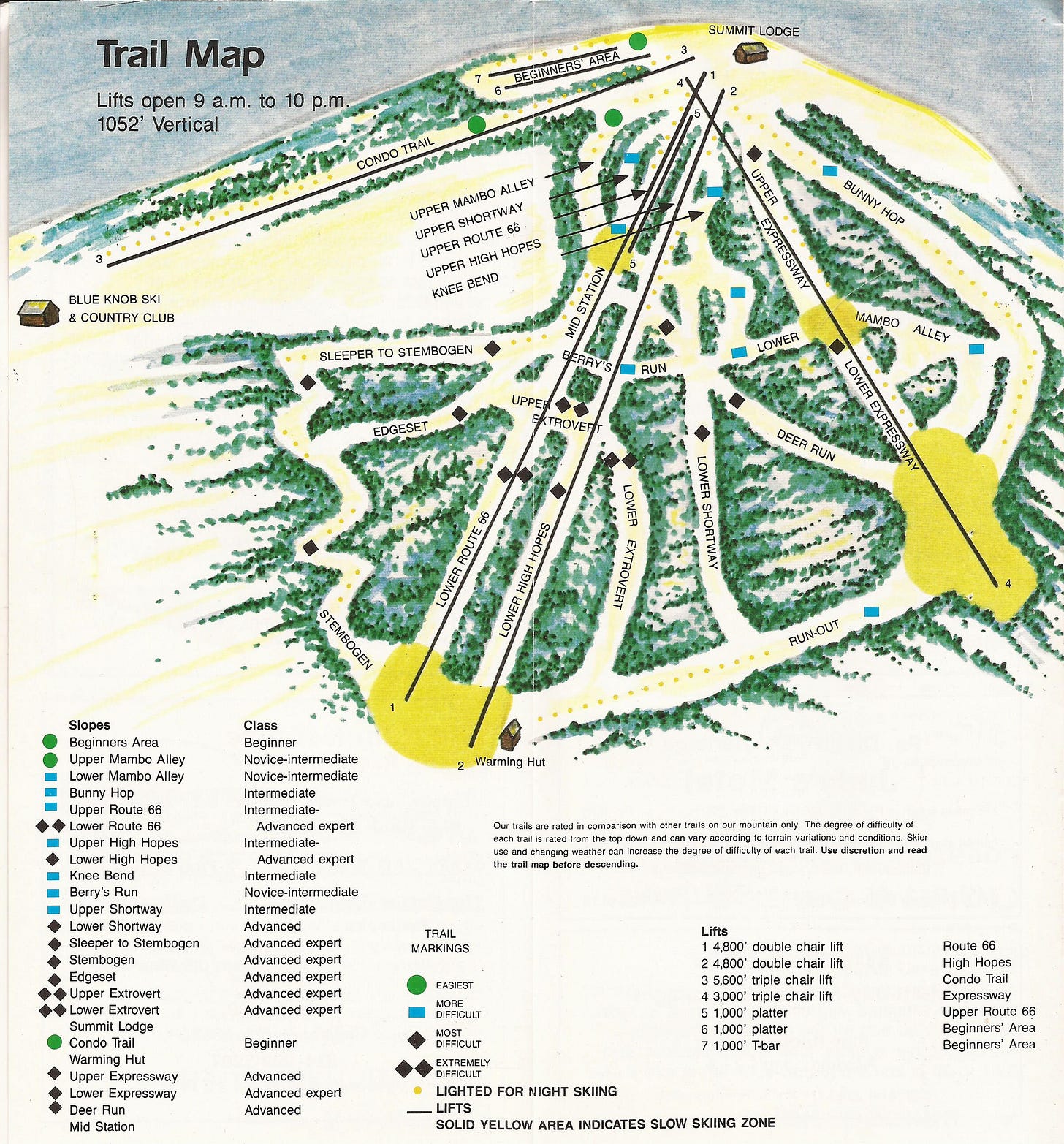
Why you should ski Blue Knob
If we took every mountain, fully open, with bomber conditions, I would rank Blue Knob as one of the best small- to mid-sized ski areas in the Northeast. From a rough-and-tumble terrain perspective, it’s right there with Berkshire East, Plattekill, Hickory, Black Mountain of Maine, Ragged, Black Mountain (New Hampshire), Bolton Valley, and Magic Mountain. But with its Pennsylvania address, it never makes that list.
It should. This is a serious mountain, with serious terrain that will thrill and challenge any skier. Each trail is distinct and memorable, with quirk and character. Even the groomers are interesting, winding nearly 1,100 vertical feet through the trees, dipping and banking, crisscrossing one another and the lifts above. Lower Shortway, a steep and narrow bumper cut along a powerline, may be my favorite trail in Pennsylvania. Or maybe it’s Ditch Glades, a natural halfpipe rolling below Stembogan Bowl. Or maybe it’s the unmarked trees of East Wall Traverse down to the marked East Wall Glades. Or maybe it’s Lower Extrovert, a wide but ungroomed and mostly unskied trail where I found wind-blown pow at 3 p.m. Every trail is playful and punchy, and they are numerous enough that it’s difficult to ski them all in a single day.
Which of course takes us to the reality of skiing Blue Knob, which is that the ski area’s workhorse top-to-bottom lift is the 61-year-old Route 66 double chair. The lift is gorgeous and charming, trenched through the forest on a narrow and picturesque wilderness line (until the mid-station, when the view suddenly shifts to that of oddly gigantic houses strung along the hillside). While it runs fast for a fixed-grip lift, the ride is quite long (I didn’t time it; I’ll guess 10 to 12 minutes). It stops a lot because, well, Pennsylvania. There are a lot of novice skiers here. There is a mid-station that will drop expert skiers back at the top of the best terrain, but this portal, where beginners load to avoid the suicidal runs below, contributes to those frequent stops.
And that’s the reality when that lift is running, which it often is not. And that, again, is because the lower-mountain terrain is frequently closed. This is a point of frustration for locals and, I’ll point out, for the mountain operators themselves. A half-open Blue Knob is not the same as, say, a half-open Sugarbush, where you’ll still have access to lots of great terrain. A half-open Blue Knob is just the Expressway (Lift 4) triple chair (plus the beginner zone), mostly groomers, mostly greens and blues. It’s OK, but it’s not what we were promised on the trailmap.
That operational inconsistency is why Blue Knob remains mostly unheralded by the sort of skiers who are most drawn to this newsletter – adventurous, curious, ready for a challenge – even though it is the perfect Storm mountain: raw and wild and secretive and full of guard dog energy. But if you’re anywhere in the region, watch their Instagram account, which usually flashes the emergency lights when Route 66 spins. And go there when that happens. You’re welcome.
Podcast Notes
On crisscrossing chairlifts
Chairlifts are cool. Crisscrossing chairlifts are even cooler. Riding them always gives me the sense of being part of a giant Goldbergian machine. Check out the triple crossing over the doubles at Blue Knob (all videos by Stuart Winchester):
Wiley mentions a similar setup at Attitash, where the Yankee Flyer high-speed quad crosses beneath the summit lift. Here’s a pic I took of the old Summit Triple at the crossover junction in 2021:

Vail Resorts replaced the triple with the Mountaineer high-speed quad this past winter. I intended to go visit the resort in early February, but then I got busy trying not to drop dead, so I cancelled that trip and don’t have any pics of the new lift. Lift Blog made it there, because of course he did, and his pics show the crossover modified but intact. I did, however, discuss the new lift extensively with Attitash GM Brandon Swartz last November.
I also snagged this rad footage of Whistler’s new Fitzsimmons eight-pack flying beneath the Whistler Village Gondola in February:
And the Porcupine triple passing beneath the Needles Gondola at Snowbasin in March:
Oh, and Lift 2 passing beneath the lower Panorama Gondola at Mammoth:
Brah I could do this all day. Here’s Far East six-pack passing beneath the Red Dog sixer at Palisades Tahoe:

Palisades’ Base-to-Base Gondola actually passes over two chairlifts on its way over to Alpine Meadows: the Exhibition quad (foreground), and the KT-22 Express, visible in the distance:
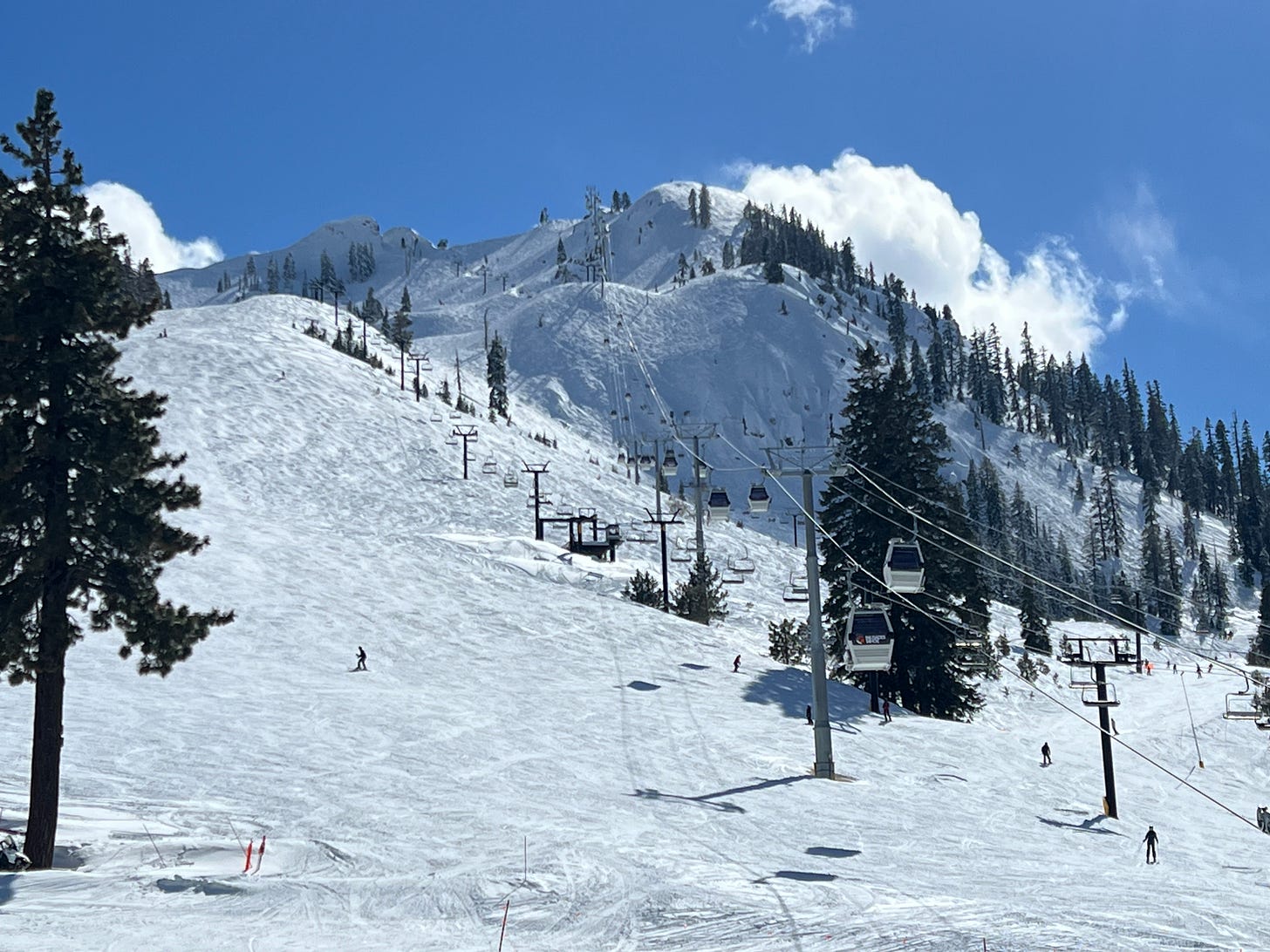
And what the hell, let’s make it a party:
On Blue Knob as Air Force base
It’s wild and wildly interesting that Blue Knob – one of the highest points in Pennsylvania – originally hosted an Air Force radar station. All the old buildings are visible in this undated photo. You can see the lifts carrying skiers on the left. Most of these buildings have since been demolished.
On Ski Denton and Laurel
The State of Pennsylvania owns two ski areas: Laurel Mountain and Ski Denton (Blue Knob is located in a state park, and we discuss how that arrangement works in the podcast). Vail Resorts, of course, operates Laurel, which came packaged with Seven Springs. Denton hasn’t spun the lifts in a decade. Late last year, a group called Denton Go won a bid to re-open and operate the ski area, with a mix of state and private investment.
And it will need a lot of investment. Since this is a state park, it’s open to anyone, and I hiked Denton in October 2022. The lifts – a double, a triple, and a Poma – are intact, but the triple is getting swallowed by fast-growing trees in one spot (top two photos):



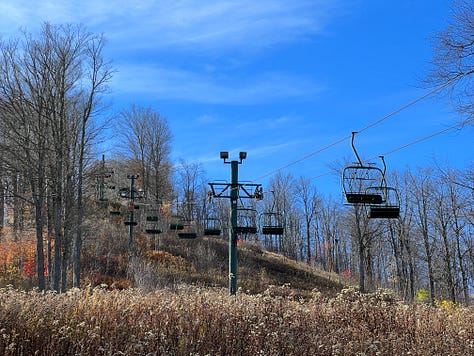





I’m no engineer, but these things are going to need a lot of work. The trail network hasn’t grown over too much, and the base lodge looks pristine, the grasses around it mowed. Here’s the old trailmap if you’re curious:
And here’s the proposed upgrade blueprint:
I connected briefly with the folks running Denton GO last fall, but never wrote a story on it. I’ll check in with them soon for an update.
On Herman Dupre and the evolution of Seven Springs
Bender spent much of his career at Seven Springs, and we reminisce a bit about the Dupre family and the ski area’s evolution into one of the finest mountains in the East. You can learn more about Seven Springs’ history in my podcast conversation with the resort’s current GM, Brett Cook, from last year.
On Ski magazine’s top 20 in the East
Ski magazine – which is no longer a physical magazine but a collection of digital bits entrusted to the robots’ care – has been publishing its reader resort rankings for decades. The list in the West is fairly static and predictable, filled largely with the Epkonic monsters you would expect (though Pow Mow won the top place this year). But the East list is always a bit more surprising. This year, for example, Mad River Glen and Smugglers’ Notch claimed the top two spots. They’re both excellent ski areas and personal favorites, with some of the most unique terrain in the country, but neither is on a megapass, and neither owns a high-speed lift, which is perhaps proof that the Colorado Machine hasn’t swallowed our collective souls just yet.
But the context in which we discuss the list is this: each year, three small ski areas punch their way into an Eastern lineup that’s otherwise filled with monsters like Stowe and Sugarbush. Those are: Seven Springs; Holiday Valley, New York; and Wachusett, Massachusetts. These improbable ski centers all make the list because their owners (or former owners, in Seven Springs’ case), worked for decades to transform small, backwater ski areas into major regional destinations.
On Vail’s Northeast Value Epic Passes
The most frightening factor in the abovementioned difficulties that Blue Knob faces in its cagefight with Vail is the introduction, in 2020, of Northeast-specific Epic Passes. There are two versions. The Northeast Value Pass grants passholders unlimited access to all eight Vail Resorts in Pennsylvania and all four in neighboring Ohio, which is a crucial feeder for the Seven Springs resorts. It also includes unlimited access to Vail’s four New Hampshire resorts; unlimited access with holiday blackouts at Hunter, Okemo, and Mount Snow; and 10 non-holiday days at Stowe. And it’s only $613 (early-bird price was $600):
The second version is a midweek pass that includes all the same resorts, with five Stowe days, for just $459 ($450 early-bird):
And you can also, of course, pick up an Epic ($1,004) or Epic Local ($746) pass, which still includes unlimited Pennsylvania access and adds everything in the West and in Europe.
Blue Knob’s season pass costs $465 ($429 early-bird), and is only good at Blue Knob. That’s a very fair price, and skiers who acted early could have added an Indy Pass on at a pretty big discount. But Indy is off sale, and PA skiers weighing their pass options are going to find that Epic Pass awfully tempting.
On comparisons to the liftline at MRG
Erf, I may have activated the Brobots at Mad Brother Glen when I compared the Route 66 liftline with the one beneath their precious single chair. But I mean it’s not the worst comparison you could think of:

Here’s another Blue Knob shot that shows how low the chairs fly over the trail:
And here’s a video that gives a bit more perspective on Blue Knob’s liftline:
I don’t know if I fully buy the comparison myself, but Blue Knob is the closest thing you’ll find to MRG this far south.
On Wolf Creek’s old summit Poma
Himes reminisced on her time working at Wolf Creek, Colorado, and the rattletrap Poma that would carry skiers up a 45-degree face to the summit. I was shocked to discover that the old lift is actually still there, running alongside the Treasure Stoke high-speed quad (the two lifts running parallel up the gut of the mountain). I have no idea how often it actually spins:
Lift Blog has pics, and notes that the lift “very rarely operates for historic purposes.”
On defunct glades
The Mine Shaft and Bone Yard glades disappeared from Blue Knob’s trailmap more than a decade ago, but this sign at the top of Lower Shortway still points toward them:
Then there’s this sign, a little ways down, where the Bone Yard Glade entrance used to be:
And here are the glades, marked on a circa 2007 trailmap, between Deer Run and Lower Shortway:
It would be rad if Blue Knob could resurrect these. We discuss the possibility on the podcast.
On Blue Knob’s base being higher than Killington’s
Somewhat unbelievably, Blue Knob’s 2,100-foot base elevation is higher than that of every ski area in New England save Saddleback, which launches from a 2,460-foot base. The five next highest are Bolton Valley (2,035 feet), Stowe (2,035), Cannon (2,034), Pico (2,000), and Waterville Valley (1,984). Blue Knob’s Vail-owned neighbors would fit right into this group: Hidden Valley sits at 2,405 feet, Seven Springs at 2,240, and Laurel at 2,000. Head south and the bases get even higher: in West Virginia, Canaan Valley sits at 3,430 feet; Snowshoe at 3,348-foot base (skiers have to drive to 4,848, as this is an upside-down ski area); and Timberline at 3,268. But the real whoppers are in North Carolina: Beech Mountain sits at 4,675, Cataloochee at 4,660, Sugar Mountain at 4,100, and Hatley Pointe at 4,000. I probably should have made a chart, but damn it, I have to get this podcast out before I turn 90.
On Blue Knob’s antique snowmaking equipment
Look, I’m no snowmaking expert, but some of the stuff dotting Blue Knob’s slopes looks like straight-up World War II surplus:

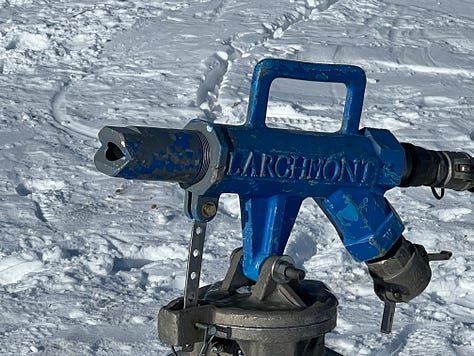



The Storm publishes year-round, and guarantees 100 articles per year. This is article 41/100 in 2024, and number 541 since launching on Oct. 13, 2019.














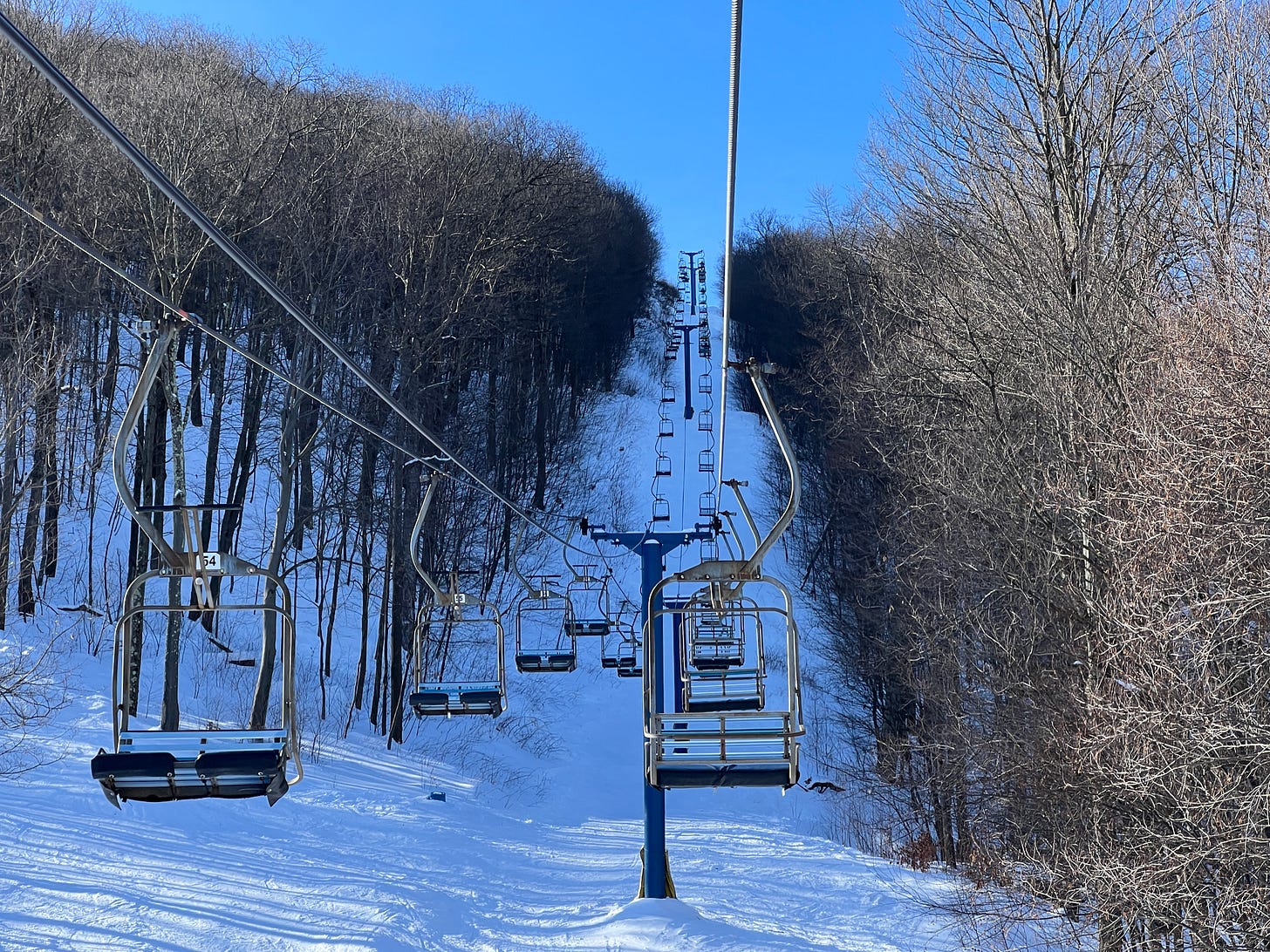

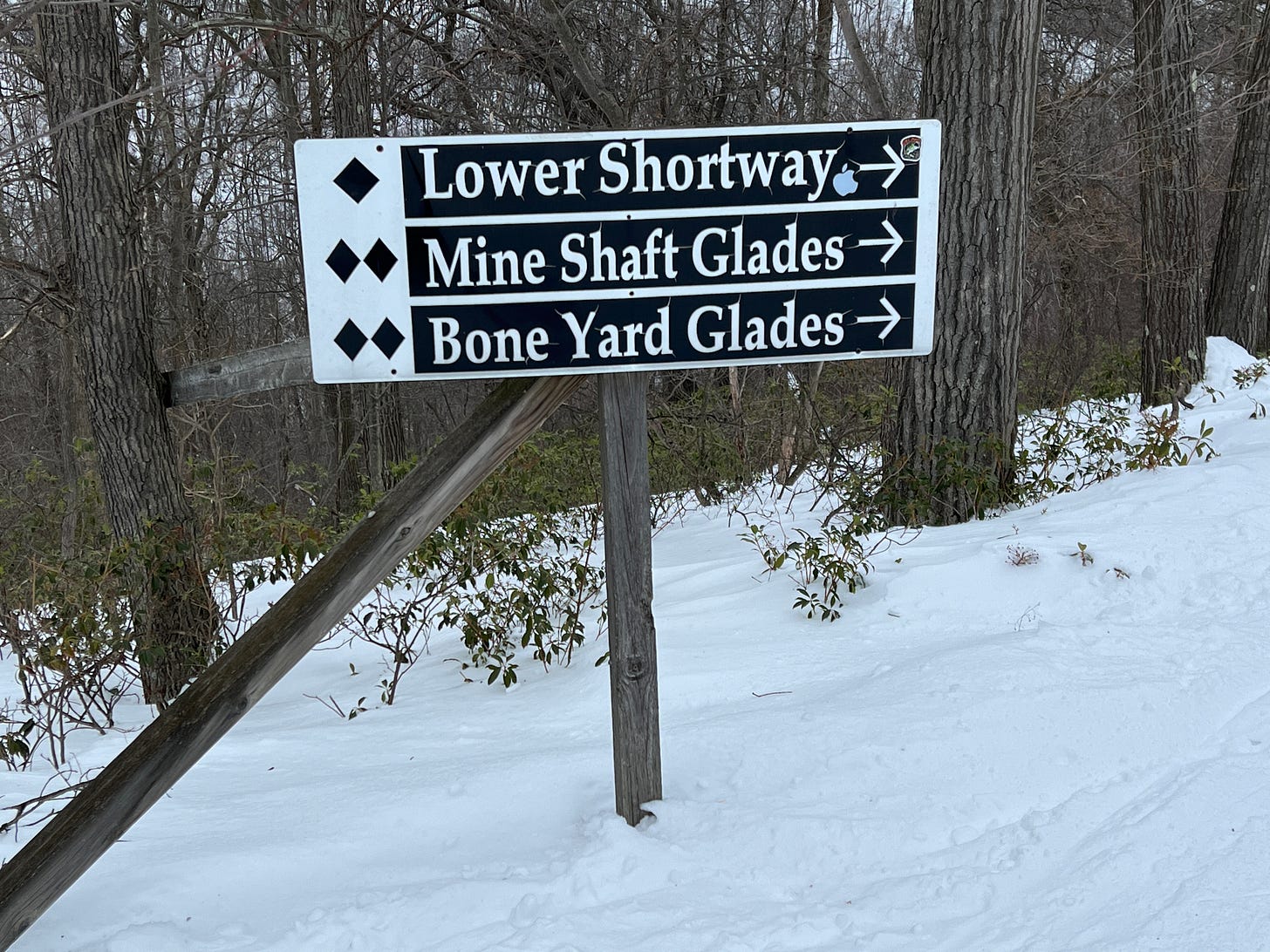








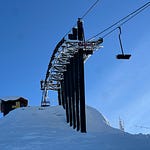


Share this post